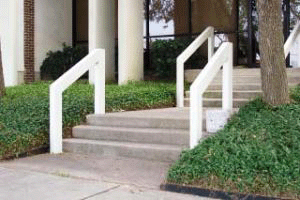Preventing Falls
 |
To prevent falling, use contrasting hand rails that go beyond the steps for a safer grasp and easier walk down the stairs. |
- Don’t store the things you need in high places that would require the use of a step stool to reach.
- Arrange your furniture so that there is a clear path for walking, and keep clutter out of walkways. Avoid using furniture on wheels.
- Clap-on/clap-off lights in the living room and in your bedroom will keep you from having to get up from your chair to adjust the lighting.
- See Household Organization for more suggestions to keep your home environment safe.
- From APH Press: Making Life More Livable: Simple Adaptations for Living at Home after Vision Loss, Third Edition, by Maureen A. Duffy, M.S., CVRT, is the essential guide for adults experiencing vision loss and is an invaluable resource for family members and friends.